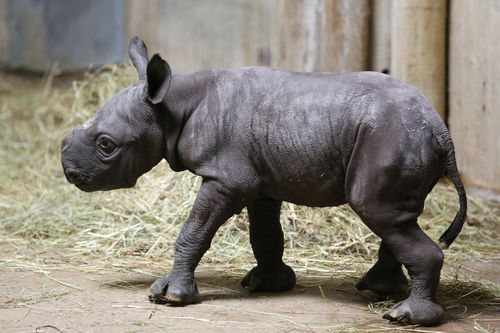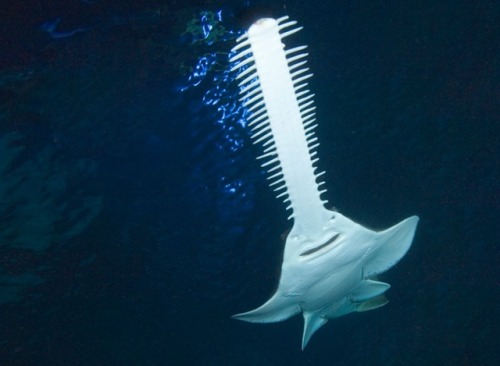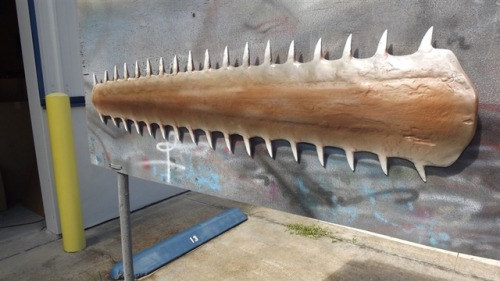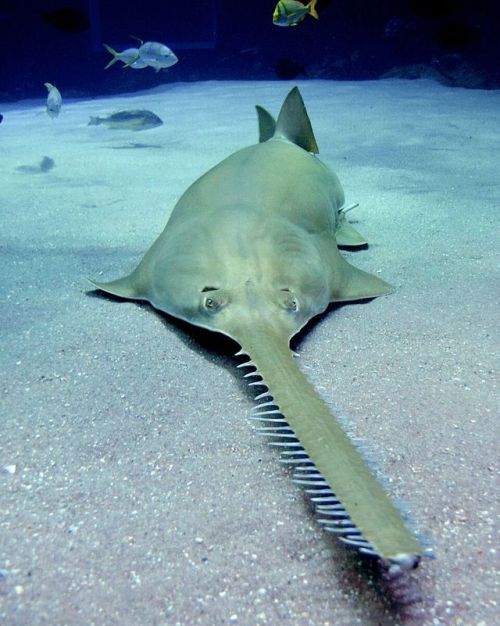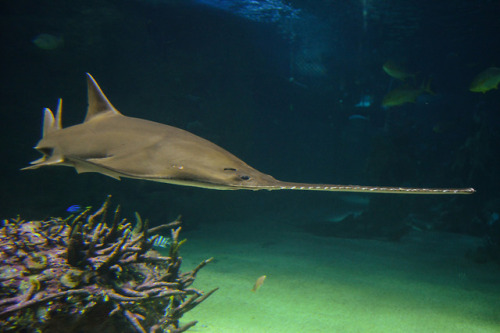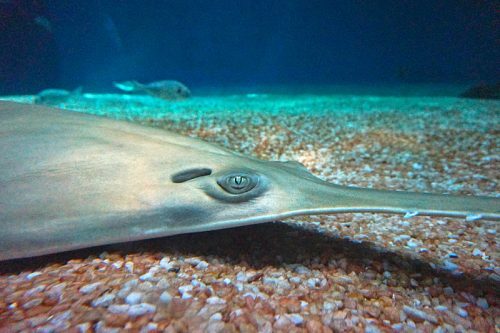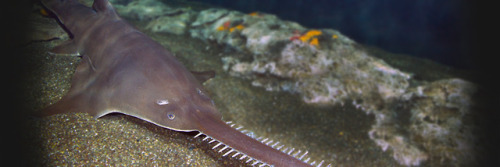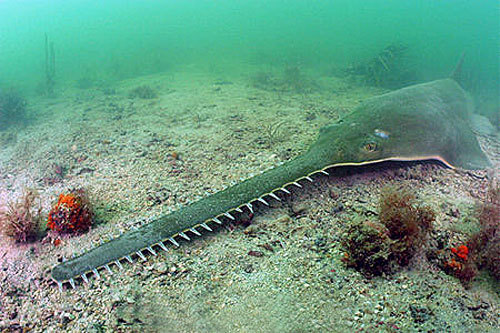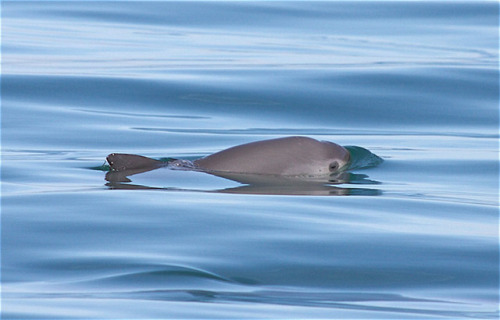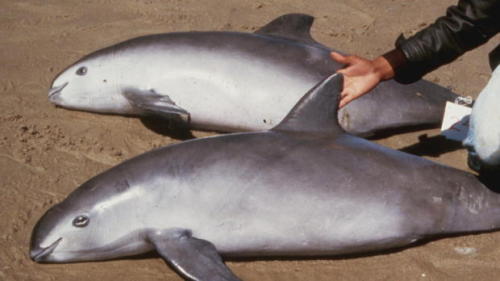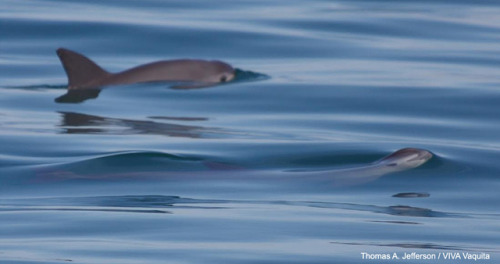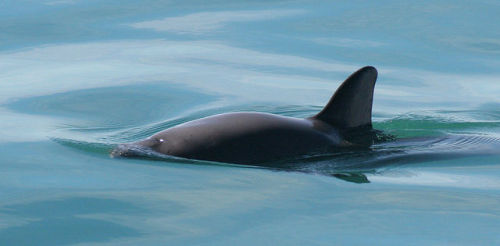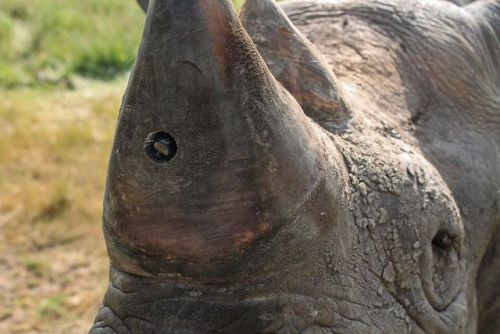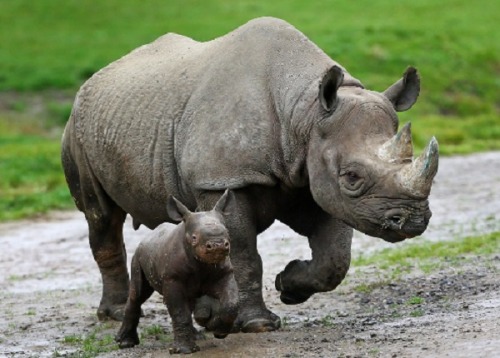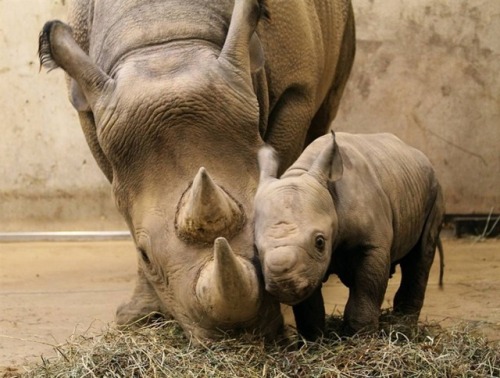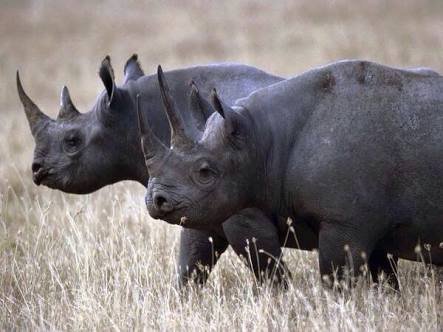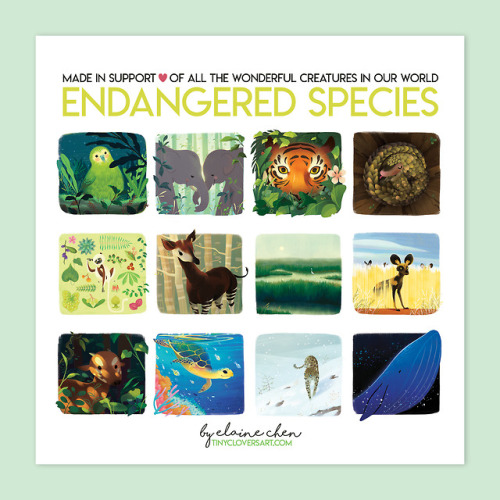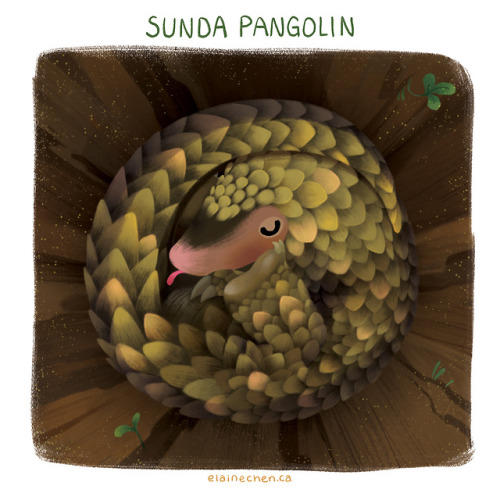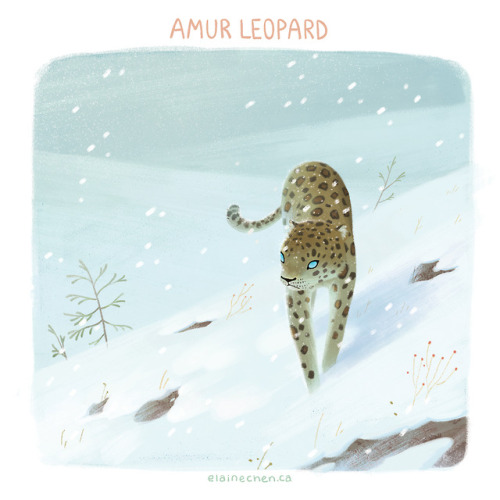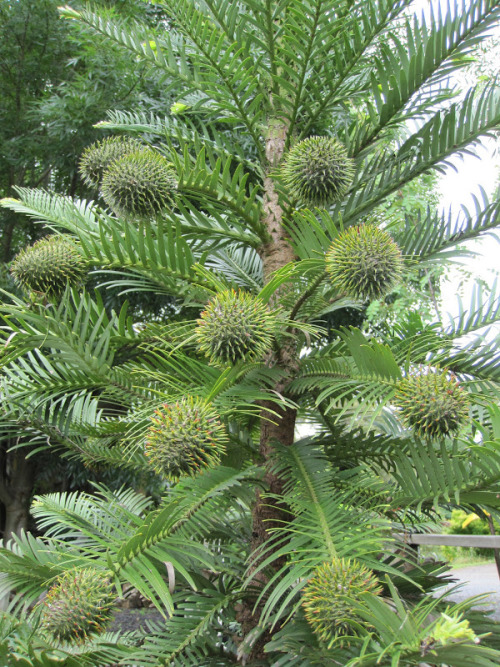#critically endangered
Black rhinos are critically endangered on the savannas of southwestern Africa and one black rhino subspecies is already extinct. Rhino horns are made of keratin, the same protein that makes your fingernails. They are extremely valuable on the black market (a ounce of rhino horn is worth more than an ounce of gold), for their uses in Eastern medicine and Middle Eastern ceremonial daggers.
Post link
Sawfish were once very common in their range, but are now amongst the most threatened marine fish. Although they are technically rays, not sharks, sawfish fins are prized for sharkfin soup, and sawfish parts are often used in Chinese, African, South American, Mexican, and Indian traditional medicine. They are also popular game fish, and their saws and teeth command high prices as souvenirs and trophies. Because of this frequent overfishing and rising pollution rates, most species of sawfish are now critically endangered.
Post link
There has been much speculation as to the purpose of the sawfish’s saw. Speculation was that they were used to literally saw chunks of meat from large prey such as whales or dolphins. In fact, the saw is lined with thousands of sensory organs that allow the sawfish to detect the electric fields emitted by living creatures, thus helping them track prey. Once a fish is detected, the sawfish will strike the prey with a sideways slash of the saw, stunning it, or else use the saw to pin it to the sea floor. While the saw is not used specifically to cut prey, a fish may be sliced in half by a particularly vigorous swipe. The saw is also used to defend the sawfish against large predators such as sharks, or in battles with rivals.
In contrast to stories of sawfish cutting through the bottom of boats or sawing humans in half, sawfish are known to be docile and harmless animals when left undisturbed.
Post link
Thegreen sawfish, also known as the longcomb sawfish or narrowsnout sawfish, is quite possibly the largest species of sawfish, historically reaching lengths of up to 24 feet. It was once found in 37 separate countries, but now populations have been confirmed in only 11. The total population of this fish has declined by over 80% in the past three generations, making it critically endangered.
Post link
Thelargetooth sawfish is not only is number 1 on the EDGE Shark list, but also has the highest-ranking score of any EDGE species! While it is also known as the common sawfish, it is now critically endangered. Once found in over 75 countries, it is present in less than a third of its former range and is considered critically endangered. It is still, however, the species of sawfish most commonly found in captivity.
Post link
Sawfish are sometimes called “carpenter sharks”, but they are actually members of the ray family. They are among the world’s largest fish, with some species reaching up to 25 feet in length. Their most recognisable feature is, of course, the long, flattened, tooth-lined rostrum protruding from their face.
Post link
While the vaquita is not deliberately hunted by humans, its downfall has been the extensive fishing of the totoaba, a fish whose swim bladder is a delicacy in China. Gill nets used to catch totoaba have quite literally massacred the vaquita - over 80% of their population disappeared between 2008 and 2015.
Government efforts to preserve the species were perfunctory - “vaquita-safe” nets proved nowhere near as effective as the old gill nets, fishermen rioted when a related fishery was shut down for fear of it being used as a cover for tatoaba poaching (ironic, as that fishery used safer nets), and compensatory monthly checks to men losing their livelihood were meager, sometimes less than a man could make in a single day’s fishing. The export of tataobas was banned and a marine reserve established, but poaching and smuggling is rampant, and there is little incentive to stop it. A single tatoaba bladder can bring in $20 000, while the fine for being caught poaching is about $500. Even now, the controversial Sea Shepherd is one of the few ships patrolling for poachers, and they can do little but film and report them. In the meantime, dead vaquita continue to be pulled from the waters.
The latest estimates say there may be only 12 vaquita left in the world. If the vaquita goes extinct, it will be the first extinction of a marine mammal since the loss of the baijiin 2006.
Post link
Thevaquita has the most restricted range of any marine cetacean, as they are endemic to the northern end of the Gulf of California. They have evolved to live in shallow, murky water, sometimes so shallow that their backs protrude from the water. Unlike many other marine animals, they can also cope with the rapid and extreme temperature changes that can occur in shallow water.
Post link
Because of the vaquita’s low numbers, the National Marine Mammal Foundation attempted to start a captive breeding program. However, after a female vaquita died of stress shortly after being captured, the program was abandoned. It is unlikely a similar program will be attempted in the future.
Post link
Thevaquita is Mexico’s only endemic marine mammal. The name vaquita is Spanish for “little cow”, and other names for the species include cochito (Spanish for “little pig”), desert porpoise, vaquita porpoise, Gulf of California harbor porpoise, Gulf of California porpoise, and gulf porpoise.
Post link
The biggest threat to the black rhinoceros is poaching for its horn. Historically, the horn was used by Middle Eastern nations to make handles and hilts for ornate ceremonial daggers called jambiyas. Demand for these daggers was so great that rhino populations plummeted 96% between 1970 and 1992. Now, most rhinos are poached for use in traditional Chinese medicine. Rhino horn for use in medicine has even been discovered for sale in the United States.
Various techniques for protecting rhinos have been attempted, from armed guards to planting cameras and trackers in their horns (second image).
Post link
Black rhinos are solitary animals except for when the females are in heat. A mating pair will stay together for days or weeks, mating several times a day. And they have stamina - a single session of copulation will last over a half-hour.
Fifteen months later, the female gives birth to a single 80 - 110 pound calf. These calves will nurse for up to two years and stay with their mothers for at least another year. Female calves may stay with their mothers even longer, forming small groups of related females.
Post link
Because of its tiny eyes, it was commonly believed that the black rhinoceros has very poor vision. In reality, however, its eyesight is relatively good, comparable to that of a rabbit. It also has excellent hearing and a powerful sense of smell.
Post link
Theblack rhinoceros is smaller than its close relative, the white rhinoceros. It also has a pointed, prehensile upper lip, meant for browsing on leaves, branches and twigs, in contrast to the white rhino’s square upper lip for grazing on grass. Black rhinos also have smaller heads and shorter necks, while white rhinos have a sloped back.
Post link
There were once eight subspecies of black rhinoceros. Three of these subspecies are now extinct, with one, the western black rhinoceros, having gone extinct in 2011. All other subspecies are critically endangered. One in particular, the Chobe black rhinoceroes, may have only one individual remaining.
Post link
search up images of the saiga antelope
it’ll be fun
Bigfoot Splayfoot Salamander - Chiropterotriton magnipes
Chiropterotriton magnipes (Caudata - Plethodontidae), is a cave dwelling salamander known only from south-eastern San Luis Potosi and eastern Queretaro, Mexico.
These little fellows have a total length of around 80-120 mm, with the tail accounting for slightly less than half of this measurement. The head is flat and wide, with large bulging eyes. This species is unique among the splayfoot salamanders in the fullness of the wedding of its feet and because it has pad-like structures on the tips of its fingers and toes.
The Bigfoot Splayfoot Salamander is listed as Critically Endangered on the IUCN Red List; it has been seen very rarely in recent years, despite searches.
Photo credit: ©Rodrigo Villegas | Locality: not indicated (2011)
Post link
HAWKSBILL SEA TURTLES are so god damned beautiful. The fact that they are Critically Endangered makes me super sad. Especially the fact that one of their biggest thread is wildlife trading. I am no scientist, so I would refer you to the big wide world of internet to learn more about them and the WWF for more ways of how we can help. Look at these 5 simple things we can do to help (that came up as first thing I googled, right here for you, easy!! haha )
Love you all humans, animals a like and mother earth <3 <3 <3
>TO BUY THIS PART OF 2019 CALENDAR CLICK HERE<
For more from this series >click here<
Post link
This 7x7 hole punched calendar is the perfect size for your wall at work or office.
Printed on matte, the paper is nice to write on and won’t smudge.
♥Each month features a unique endangered animal.
♥Each page have a short blurb about the animal and maybe some fun facts.
♥Holidays were all researched and personally organized
(therefore, please forgive possible mistakes >.< )Thank you for your support!
Love, Elaine and the animals.
Not much left in stock! Make sure to snag one before this current batch runs out.
All proceeds will go towards organizations helping these animals. Most I have talked about and researched >>HERE<< in these individual posts. And you can see the bigger pictures of them there if you wanted spoilers.
Post link
MALAYAN TIGER can only be found in Malaysia and Thailand’s southern tip. Dense tropical forests and areas close to rivers is where they most like to inhabit. Only about 250-340 of them left in the wild, they are considered critically endangered. Their strips are thinner compared to those of other tiger and are great camouflagers.
Keeping the populations of wild boars under control is just one of the reasons they are valuable to humans. They also like to eat deer, cattle and goats. Like other subspecies of tiger, their hunting style is stealthy and quick to kill. They can run up to 96km/h! Their coats are pretty but let’s leave it on them and not as hunting trophies =(
For more about these cool cats and see ways you can help: Adopt a tiger:3
>TO BUY THIS PART OF 2019 CALENDAR CLICK HERE<
For more from this series >click here<
Post link
SUNDA PANGOLIN is one of 8 species of pangolin, and these little guys are from Southeast Asia. Sunda Pangolin or Malayan Pangolin prefer forests and may burrow in trees like this one. Their unique scales, (which are made out of same protein as our hair and nails!) are great protection for them when they are feasting on ant colonies that probably won’t like that very much.
Other than their large, curved claws, their super long tongue and super sticky saliva are great for digging into those trees and log to find their meal. They also walk on their hind legs while balancing with their long tail, giving them a super cute and funny walk.
They are unfortunately one of the world’s most trafficked mammals due to their meat being considered a delicacy and their scales being used in traditional medicine throughout Asia. Them reproducing only once per year doesn’t really help. If we want to keep those termites out of our houses and a stable balance in our ecosystem, as well as just to keep these cool guys around, we should continue to spread awareness and protect them!
For more from this series >click here<
>TO BUY THIS PART OF 2019 CALENDAR CLICK HERE<
Calendar making update:
Hey folks! As I have a slow traffic on tumblr, I am going to continue to post these individual pages here, for those whoever stumbles across them. And those who choose to take a closer look at each of the month’s illustrations before deciding to purchase one instead of keeping some as a surprise.
I also do enjoy writing out a little description for each of these creatures. <3
Post link
AMUR LEOPARD is a rare subspecies of leopards that live in northern regions. Therefore their coat is usually paler compared to their other leopard siblings and have larger and more spaced out rosettes. The coat can grow up to 7.5cm in the winter and is soft and dense.
Currently they are listed as critically endangered and there were less than 60 of them in the wild in 2016. Habit loss and hunting of their coat is one of the main causes for the small population. Maintaining a good prey population is also crucial in their recovery. Even though the Amur leopard is at the top of their food chain and an apex predator, they are finding it hard to survive! Let’s help them out by logging more sustainable for a start and/or adopt one of these little guys :O
Organizations that help Amur Leopards: WildCats,WWF
>TO BUY THIS PART OF 2019 CALENDAR CLICK HERE<
For more from this series >click here<
Post link

